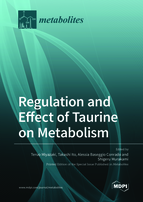Regulation and Effect of Taurine on Metabolism
A special issue of Metabolites (ISSN 2218-1989). This special issue belongs to the section "Nutrition and Metabolism".
Deadline for manuscript submissions: closed (15 April 2022) | Viewed by 32115
Special Issue Editors
Interests: energy metabolism; exercise; skeletal muscle; biochemistry; amino acids
Special Issues, Collections and Topics in MDPI journals
Interests: taurine; food factor; aging
Special Issues, Collections and Topics in MDPI journals
Interests: sulfur natural compound; oxidative stress; antioxidants; phototoxicity; food allergy
Special Issues, Collections and Topics in MDPI journals
Interests: obesity; diabetes; hepatic steatosis; lipid metabolism
Special Issues, Collections and Topics in MDPI journals
Special Issue Information
Dear Colleagues,
Since taurine (2-aminoethanesulfonic acid) was discovered in the gall bladder of bovine in 1827, a lot of its physiological and pharmacological functions have been found in various tissues, cells, and organelles in many species in 200 years. Taurine has been recognized as an essential nutrient associated with various metabolisms to maintain healthy conditions, prevent various diseases, and support growth and aging. Taurine abundantly exists as a free form in the body, and its metabolites, such as its conjugated bile acids, taurine chloramine, its modified mitochondrial t-RNA, hypotaurine, thiotaurine, and acetylated, acylated, and methylated forms, also have important roles in the functions of taurine. In this Special Issue, we welcome researchers to submit original research, review articles, or clinical data focused on the regulation and effect of taurine on metabolism in various pathways of all species in wide fields, including biochemistry, physiology, biology, molecular biology, basic and clinical medicine, sport and exercise science, neuroscience, radiology, immunology, nutrition, food science, marine science, and others.
Dr. Teruo Miyazaki
Dr. Takashi Ito
Dr. Alessia Baseggio Conrado
Dr. Shigeru Murakami
Guest Editors
Manuscript Submission Information
Manuscripts should be submitted online at www.mdpi.com by registering and logging in to this website. Once you are registered, click here to go to the submission form. Manuscripts can be submitted until the deadline. All submissions that pass pre-check are peer-reviewed. Accepted papers will be published continuously in the journal (as soon as accepted) and will be listed together on the special issue website. Research articles, review articles as well as short communications are invited. For planned papers, a title and short abstract (about 100 words) can be sent to the Editorial Office for announcement on this website.
Submitted manuscripts should not have been published previously, nor be under consideration for publication elsewhere (except conference proceedings papers). All manuscripts are thoroughly refereed through a single-blind peer-review process. A guide for authors and other relevant information for submission of manuscripts is available on the Instructions for Authors page. Metabolites is an international peer-reviewed open access monthly journal published by MDPI.
Please visit the Instructions for Authors page before submitting a manuscript. The Article Processing Charge (APC) for publication in this open access journal is 2700 CHF (Swiss Francs). Submitted papers should be well formatted and use good English. Authors may use MDPI's English editing service prior to publication or during author revisions.
Keywords
- Metabolism
- Metabolites
- In vivo study
- In vitro study
- Taurine and its derivatives
- Taurine conjugated metabolites










